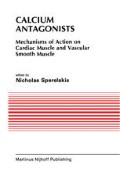Abstract
The use of Ca slow channel blockers for the prevention and treatment of ischemic heart diseases has received a wide acceptance in these recent years (1–4). In spite of their potential effectiveness to prevent Ca overload in reversibly injured myocardial cells (5,6), there is as yet little evidence that these slow channel blockers foster any therapeutic interest for the treatment of primary cardiomyopathies. The hamster hereditary cardiomyopathy includes several of the pathologic components which characterize spontaneously-occurring heart cell degeneration (7,8). The myocardial changes that progressively develop in these animals are an expression of a more generalized myopathic process which in all probability derives from an identical genetic molecular defect(s). Some ten years ago, we demonstrated that verapamil, one of the earliest Ca slow channel blockers, prevented the hamster hereditary cardiomyopathy without changing the overall course of the generalized polymyopathy that prevails in these animals (7,9). Until now, the effectiveness of verapamil in hindering the progression of skeletal muscle changes has remained unexplained except for the fact that presumably Ca slow channel blockers have no direct physiologic or pharmacologic effect on skeletal muscle fibers in higher vertebrates (10,11). Indeed therapeutic trials with prenylamine and verapamil were found unsuccessful in human muscular dystrophy (12,13).
Access this chapter
Tax calculation will be finalised at checkout
Purchases are for personal use only
Preview
Unable to display preview. Download preview PDF.
References
Nayler WG: The role of calcium in the ischemic myocardium. Amer J Pathol (102): 262–270, 1981.
Schwartz A, Grupp G, Millard RW, Grupp IL, Lathrop DA, Matlib MA, Vaghy PL, Valle JR: Calcium-channel blockers: possible mechanisms of protective effects on the ischemic myocardium. In: Weiss GB (ed) New Perspectives on Calcium Antagonists. The Williams & Wilkins Co., Baltimore, Maryland, 1981, pp. 191–210.
Henry PD, Clark RE, Williamson JR: Protection of the globally ischemic heart with calcium-antagonists: improved recovery after cardiopulmonary bypass. In: Fleckenstein A, Roskamm H (eds) Calcium -Antagonismus. Springer-Verlag, Berlin, Heidelberg, New York, 1980, pp. 181–190.
Hecht HS, Chew CYC, Burnam MH, Hopkins J, Schnugg S. Singh BN: Verapamil in chronic stable angina: amelioration of pacing-induced abnormalities of left ventricular ejection fraction, regional wall motion, lactate metabolism and hemodynamics. Amer J Cardiol (48): 536–544, 1981.
Sperelakis N, Schneider JA: A metabolic control mechanism for calcium ion influx that may protect the ventricular myocardial cell. Amer J Cardiol (37): 1079–1085, 1976.
Fleckenstein A: Specific inhibitors and promoters of calcium action in the excitation-contraction coupling of heart muscle and their role in the prevention or production of myocardial lesions, in: Harris P, Opie LH (Eds) Calcium and the Heart. Academic Press, London and N.Y., 1971, pp. 135–188.
Jasmin G, Bajusz E: Polymyopathie et cardiomyopathie héréditaire chez le hamster de Syrie. Inhibition sélective des lésions du myocarde. Ann Anat Pathol (18): 49–66, 1973.
Jasmin G, Proschek L: Hereditary polymyopathy and cardiomyopathy in the Syrian hamster. I. Progression of heart and skeletal muscle lesions in the UM-X7.1 line. Muscle Nerve (5): 20–25, 1982.
Jasmin G, Solymoss B: Prevention of hereditary cardiomyopathy in the hamster by Verapamil and other agents. Proc Soc Exp Biol Med (149): 193–198, 1975.
Nayler WG: Calcium antagonists. In: Shibata S, Bailey LE (eds) Recent Developments in Cardiac Muscle Pharmacology. Chapter 7. Igaku-Shoin, Tokyo, 1982, pp. 99–124.
Stull JT, Sanford CF: Differences in skeletal, cardiac and smooth muscle contractile element regulation by calcium. In: Weiss GB (ed) New Perspectives on Calcium Antagonists. The Williams & Wilkins Co., Baltimore, Maryland, 1981, pp. 35–46.
Vanasse M, Jasmin G, Marois P, Lapierre-Barabe L, Proulx A, Geoffroy G, Le Lorier J: A therapeutic trial with Prenylamine, a calcium antagonist, in Duchenne muscular dystrophy. Vth Intern. Congress of Muscular Diseases, Marseille, France, 1982.
Emery AEH, Skinner R, Howden LC, Matthews MB: Verapamil in Duchenne muscular dystrophy. The Lancet (1): 559, 1982.
Jasmin G, Proschek L: The paradoxical effect of Isoproterenol on hamster hereditary polymyopathy. Muscle Nerve (6): 408–415, 1983.
Proschek L, Jasmin G: Hereditary polymyopathy and cardiomyopathy in the Syrian hamster. II. Development of heart necrotic changes in relation to defective mitochondrial function. Muscle Nerve (5): 26–32, 1982.
Jacobson BE, Blanchaer MC, Wrogemann K: Defective respiration and oxidative phosphorylation in muscle mitochondria of hamsters in the late stages of hereditary muscular dystrophy. Can J Biochem (48): 1037–1042, 1970.
Chance B, Williams GR: The respiratory chain and oxidative phosphorylation. Adv Enzymol (17): 65–134, 1956.
Lowry OH, Rosebrough NJ, Farr AL, Randall RJ: Protein measurement with the Folin phenol reagent. J Biol Chem (193): 265–275, 1951.
Triggle DJ: Calcium antagonists: basic chemical and pharmacological aspects. In: Weiss GB (ed) New Perspectives on Calcium Antagonists. The Williams & Wilkins Co., Baltimore, Maryland, 1981, pp. 1–18.
Jasmin G, Proschek L: Calcium and myocardial cell injury. Can J Physiol Pharmacol (in press).
Editor information
Editors and Affiliations
Rights and permissions
Copyright information
© 1984 Martinus Nijhoff Publishing, Boston
About this chapter
Cite this chapter
Jasmin, G., Proschek, L. (1984). Comparative Effects of Ca Slow Channel Blockers on the Hamster Hereditary Cardiomyopathy. In: Sperelakis, N., Caulfield, J.B. (eds) Calcium Antagonists. Developments in Cardiovascular Medicine, vol 39. Springer, Boston, MA. https://doi.org/10.1007/978-1-4613-3810-9_17
Download citation
DOI: https://doi.org/10.1007/978-1-4613-3810-9_17
Publisher Name: Springer, Boston, MA
Print ISBN: 978-1-4613-3812-3
Online ISBN: 978-1-4613-3810-9
eBook Packages: Springer Book Archive

